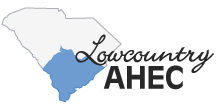History
The AHEC (Area Health Education Centers) program was developed by Congress in 1971 to recruit, train, and retain a health professions workforce committed to underserved populations. The AHEC program helps bring the resources of academic medicine to address local community health needs. AHECs have a continual focus on improving the health care system by working with academic institutions, health care settings (including CHCs), behavioral health practices, and community-based organizations. Through these longstanding partnerships, the AHECs employ traditional and innovative approaches to develop and train a diverse health care workforce prepared to deliver culturally appropriate, high-quality, team-based care, with an emphasis on primary care for rural and underserved communities.
The South Carolina AHEC system was created in 1972 as one of the original eleven programs funded by Congress. Begun through a consortium of four teaching hospitals, two medical schools, and four regional centers, by 1987, the SC AHEC network included a Program Office, six regional teaching hospitals, seven education centers, and the state’s two medical schools, and its original focus on physician shortages had expanded to include programs and services addressing the state’s nursing, allied health, and minority recruitment needs.
In 2000, in an effort to become more efficient and cost effective, a strategic decision was made to reorganize the SC AHEC Centers, downsizing from seven to the four we have today. This resulted in little change for Pee Dee and Lowcountry AHEC. However, the former Catawba-Wateree and Midlands AHECs were merged to create Mid-Carolina AHEC; and the fourth Center, Upstate AHEC, was established by combining three Centers: Spartanburg AHEC, Greenville AHEC, and Upper Savannah AHEC.
To find out more about the National AHEC, visit the National AHEC Organization website.
